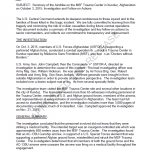
On Oct. 3, 2015, members of U.S. Forces-Afghanistan (USFOR-A) supporting a partnered Afghan force, conducted a combat operation that struck Trauma Center in Kunduz operated by Médecins Sans Frontières (MSF), also known as “Doctors without Borders.” U.S. Army Gen. John Campbell, then the Commander of USFOR-A, directed an investigation to determine the cause of this incident. The lead investigating officer was Army Maj. Gen. William Hickman. He was assisted by Air Force Brig. Gen. Robert Armfield and Army Brig. Gen Sean Jenkins. All three generals were brought in from outside Afghanistan in order to provide an objective perspective. The investigation team included over a dozen subject matter experts from several specialty fields.
